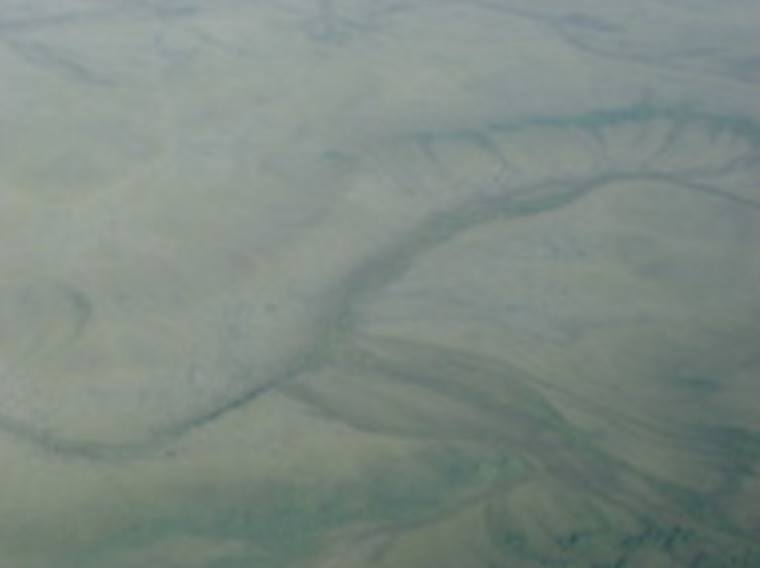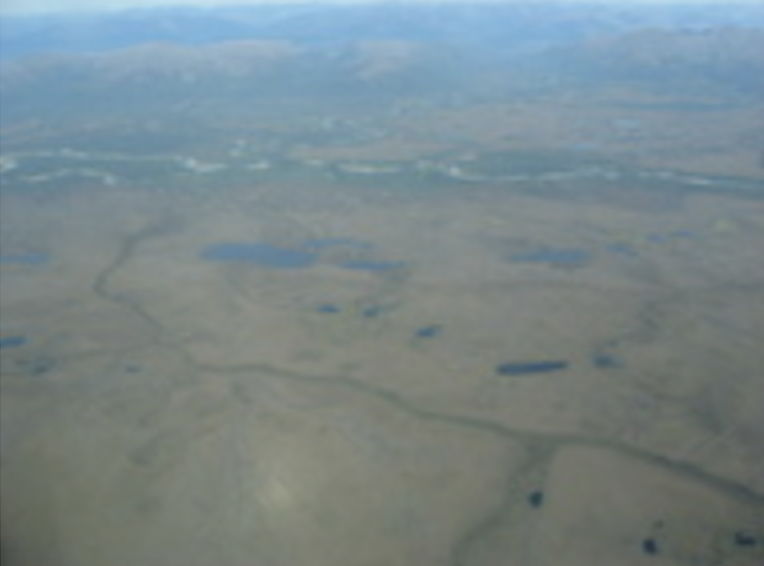The waters of the Kobuk are often called "gin-clear", because of the visibility that allows one to see straight to the bottom. This is due to the lack of glaciation at the headwaters. Glaciers grind up rock and sediment and deposit into rivers as fine, powdery sediment, often called "glacial milk". The low precipitation of the Kobuk watershed has prevented glacier formation; snow melts more or less completely by July. The lack of turbidity in the water allows light to penetrate deeply, and we discovered mats of algae (diatomaceous periphyton, filamentous algae), and patches of aquatic plants and mosses (macrophytic vegetation) everywhere the bottom was protected from scouring during the summer. Other Arctic rivers, which are generally limited by nitrogen or phosphorous, or both, have been shown to have most of their limited production at the interface between moving water and substrate (the epilithos), which allows for a concentration of nutrients at that surface. This appears to be true of the Kobuk, but we were surprised at the consistent quantity of plant growth.
Likewise, the density and diversity of aquatic insects surprised us, as did the density of zooplankton in backwaters and adjacent ponds. In contrast, fish are few and when they do show up, they hit lures and flies aggressively. Most of the fish that we saw were on spawning migrations (chum salmon and shee), or following spawners (Arctic grayling). A fair number of fish that we captured contained terrestrial animals in their guts.
Mammals and birds also seemed rare on the river (although insects—mosquitoes—were moderately abundant). From where does nitrogen originate? How do nutrients flow through the system? By what mechanisms are they retained?
Some Arctic systems rely upon a few large, mobile sequestration agents—i.e., mammals such as bears—for maintenance of nitrogen in the system. That may be the case for the Kobuk as well, but how does that scarce nitrogen get distributed and sequestered in the system? In other words, why doesn't it simply flow out and under the tundra and dump into this big river and be gone?
I think that some of the answer is in the structure of the river and its adjacent communities. It may be that adjacent ponds, oxbow lakes and backwaters "grab" available nutrients and divert it into primary (i.e., algae) and secondary production (i.e., aquatic insects, copepods and cladocerans). There, nutrients may be somewhat protected from rapid dissemination, and have four fates:
1. Maintained in plant tissues until grazed or released by senescence.
2. Maintained in aquatic arthropod tissues and diverted to the foodweb until excreted or released by senescence.
3. Trapped by freezing during winter and transported regionally during breakup.
4. Released via hyporheic flow into the river.
As a result of this cycle, and the fact that the system is on an incline—that is, a river—all nitrogen must eventually leave the system, even if the speed of loss is mediated biologically. As a result, some new nitrogen must be introduced to the system. It is presumably be introduced in one of three ways:
1. Via precipitation—probably not a large source.
2. Via animal migrations—also not a large source, because most migrations are two way. Nonetheless, certain migrations have the potential to leave a bit of nitrogen, particularly chum salmon, which import estuarine nutrients and then die, leaving it in the system. However, we saw more chum at the bottom of the river than on the banks, suggesting that a fair fraction of chum-derived nutrients are lost to the river. Other migratory animals may deposit nitrogen if they are killed or die while within the ecosystem; over-wintering caribou hunted by wolves is an example of this.
3. Nitrogen fixation by blue-green algae and by tundra lichens. Lichens appear to be an important source of terrestrial fixation, most of which is stored in the plant, in herbivores, or in ponds as mentioned above.
Sequestration in ponds and backwaters may have a dual role: it provides a source of nitrogen for production, and then probably episodically releases the resulting production during periodic flooding throughout the summer. We noted evidence of flooding throughout these backwaters. These releases may be vital to support juvenile suckers, whitefish and grayling, which were seined in significant numbers around these backwaters. Pike, in turn, were found to be following these aggregations of juveniles, at least in some areas.


References
Alexander V and Shell DM. 1973. Seasonal and spatial variation of nitrogen fixation in the Barrow, Alaska, tundra. Arctic and Alpine Research. 5(2): 77-88.
Erskine PD, Bergstrom DM, Schmidt S, Stewart GR, Tweedie CE and Shaw JD. 1998. Subantarctic Macquarie Island—a model ecosystem for studying animal-derived nitrogen sources using 15N natural abundance. Oecologia 117(1): 187-193.
